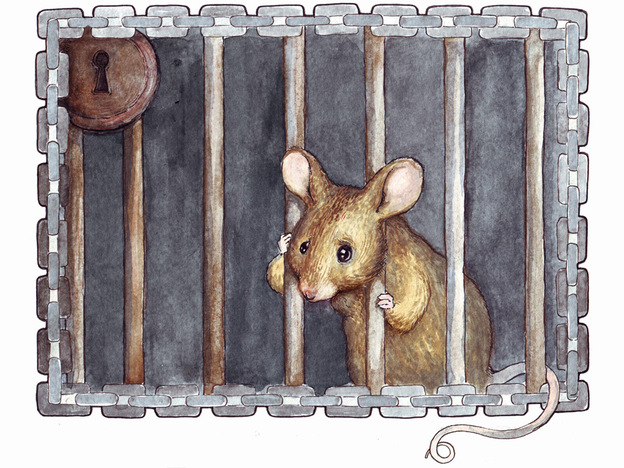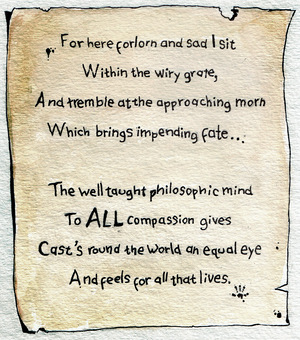Reply
Sun 25 Apr, 2010 09:53 am
 Early Animal Rights Poem Discovered: A Mouse's Plea
by ROBERT KRULWICH
Early Animal Rights Poem Discovered: A Mouse's Plea
by ROBERT KRULWICH
 http://www.npr.org/templates/story/story.php?storyId=126051517
http://www.npr.org/templates/story/story.php?storyId=126051517
Quote:April 21, 2010
He was just an ordinary mouse, nothing special. He lived, very briefly, 237 years ago, in the laboratory of a great chemist, Joseph Priestley. Here he sits, in his cage.
Benjamin Arthur
There were lots of mice in Priestley's lab. He had made his reputation as one of the first scientists to identify oxygen. He studied mice to figure out what happens inside animals as they breathe. This meant he regularly opened them to examine lungs, veins, arteries, to see that blood changed color when it moved through lungs. And since tuberculosis -- or "consumption" -- was the scourge of that era, lung research seemed like a valuable thing to do.
But animals didn't last long in Priestley's lab, especially mice. So many died that his lab assistant, a young woman named Anna Barbauld, decided that Priestley should give his lab animals a little more respect. It was, after all, 1773, just a few years before Lexington, Concord and the Declaration of Independence. On both sides of the Atlantic, "inalienable rights" were a rallying cry, and Anna, a young wife and poet, decided to write a protest poem. She called it "The Mouse's Petition to Dr. Priestley, Found in the Trap where he had been Confined all Night."
For the rest of the intriguing article:
http://www.npr.org/templates/story/story.php?storyId=126051517
This reminds me very much of Jack Kerouac's angst regarding a mouse he killed, in the book, Desolation Angels. He had long held himself above the animal murderers, and had now to join the ranks of them whose actions he despised.
Yesterday, I found a remaindered book that I will send to my granddaughter's tomorrow. It is about a mouse that lived in Emily Dickinson's house and became a poet. A sweet fantasy.
Later, I had a talk with a liquor store customer, a heavily tatooed man who never wears shirts but a black leather vest on his naked chest. He is a Gulf War vet, still dealing with the effects of having killed other humans. He is also involved in animal rescue work. He told me of the horse he just acquired. When its original owner bought it, it was an unbroken gelding. He put his four year old son on the horse and the horse threw him. The man hit the horse with a baseball bat. He then brought in two dogs which he said he found floating on a door in St. Bernard's Parish after Katrina. The dogs were obviously affectionate with the man and launched their repertoire of tricks.
Somehow, these two stories just go with your post.
Then there is the mouse that roared. Guess what that is from.

Or Leo Leoninni's lovely story about the mouse that stored up the sights and smells of summer and shared them his friends during the cold and dark of winter. A lovely description of the purpose of an artist in society.
@Letty,
Archduchy of Fenwick, I presume.
@roger,
Remember Peter Sellers in the movie The Mouse that Roared? What a great adaption from the Archduchy's books.
@tsarstepan,
The language and style used inthe poem strike me as unusual for this period.
I've not yet read the full artical however i wonder if this is true.
This is more convincing however no provenance is provided.

@dadpad,
dadpad, I wondered the same thing when I read the original story in the NYTimes